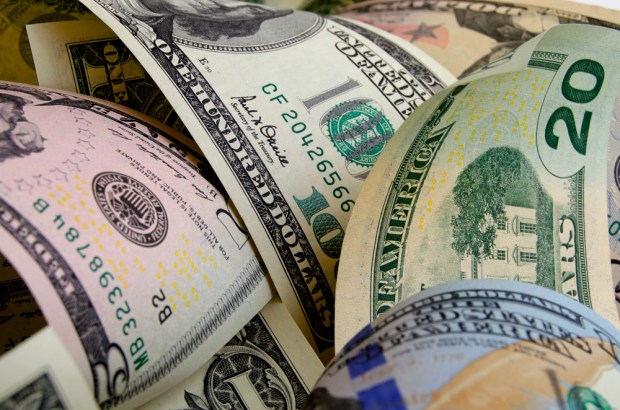Despite The Digital Age, Cash Is In The Pink (OK, Green) Of Health

Cashless? Not yet. Not by a long shot. Cash still holds sway as the preferred payment method across a variety of options, as found by Cardtronics in a recent study. Turns out the green stuff is healthy (we ain’t talkin’ spinach). PYMNTS’ Karen Webster delves into the state of cash usage with Cardtronics’ North American Managing Director Brian Bailey.
Cash is thriving, despite the emergence of bits and bytes.
That statement may come as a surprise against a backdrop where digital wallets and eCommerce have grabbed their share of headlines and acclaim in the payments world. But as readers in this space know, the move to cashless is not a done deal, nor is it written in the cards (no pun intended).
A recent whitepaper by Cardtronics, in partnership with Edelman Intelligence for its 2017 Health of Cash study, has been titled “In a Digital World, Cash is Resilient.” That study, the third annual, surveyed 1,000 adults across the United States. The headline findings? Cash may not be the preferred method of payment in all scenarios – but then again, it holds its own.
The Cardtronics data dovetails a bit with PYMNTS’ own findings that total cash usage is up on a global basis. As many as 40 percent of all transactions in the U.S. are done with greenbacks, and in Europe, cash spending as a share of GDP ranges from 29 percent in Spain to 4.5 percent in Switzerland.
As for the Cardtronics study, consider that in the United States, digital payments have grown by 16 percent year over year. That’s had some impact on cash payments – how could it not? – as cash usage has slipped by 4 percent in the same period.
Despite that slippage, cash remains, overall, the most widely used payments conduit, the study found. The latest data shows that cash is used by 91 percent of people for in-store purchases or peer-to-peer (P2P) payments, down from 95 percent last year. In addition, 80 percent of respondents use cash each month.
In an interview conducted by PYMNTS’ Karen Webster with Brian Bailey, managing director for North America at Cardtronics, the discussion turned to why and how cash has remained so sticky. The data shows that cash still runs a good, solid second place among preferred payment methodologies – cited by 27 percent of respondents as their top choice, behind debit cards at 33 percent.
Bailey said that granular detail shows some generational divide here. Millennials represent what the executive termed a “P2P native” segment, with 67 percent of individuals using cash for payments (P2P) versus 62 percent for all age groups. This means, said Bailey, that the younger set is moving away from traditional banking products and services (such as debit and credit cards) and embracing the hard stuff via paper and coins.
Webster posited that ubiquity plays a role for cash usage. Bailey agreed, with the observation that there are thresholds for using cash. The key here is that people tend to use cash for small-value purchases, where 55 percent of people use cash for transactions under $20 and 68 percent do so when buying goods and services under $10.
Even at digitally enabled places of commerce, when a business with a Square terminal has a $4 minimum in place for cards, people start digging into wallets. In fact, 61 percent of respondents said they “get upset” when establishments do not accept cash.
Though Bailey noted that “the war on cash has been officially waged,” he stated that eight out of 10 respondents said they would miss cash if it were to go away. “Choice is paramount” when it comes to payments, he said. Cash can sometimes take on an urgency as a payment methodology, he added.
Think of natural disasters or the spate of hurricanes that hit islands and the U.S. mainland in recent weeks, where electricity has been knocked out for days or weeks. That environment renders digital banking inaccessible. Thus, the runs on cash (and at least some financial security) remind us that notes and coins remain a bedrock of value when people need to “cash up ahead of time,” as Bailey termed it.
And, Bailey added, some of the immediate emergency repair work done by contractors on site needs to be paid for in cash. The electricity may still be out and the ATMs and debit cards still inaccessible, but the windows, roofs and doors need patching. In this way, cash becomes the instant, and most utilitarian, form of commerce.
Call it cash as comfort, as 67 percent of all consumers said they “feel nervous” when they do not have cash on them or in their wallets.
Get ready for that green security blanket to feel a bit, well, more secure in a post-Equifax data breach age. Bailey stated that cash is likely to maintain its allure due to the private nature of transactions, holding its position as a preferred methodology when shopping at convenience stores and other relatively smaller establishments, especially for routine purchases. Cash in hand also helps control spending, agreed Bailey and Webster. The concept is a simple one: You are limited by what you put in your pocket.
The topic of financial inclusion is also important, said Bailey. Federal Deposit Insurance Corporation (FDIC) stats show that nine million households were unbanked in 2015. If cash were banished, that segment of society would be disadvantaged. In terms of access, cash is available to everyone, used by 94 percent of the population. These Americans, said Bailey, are “upwardly mobile, but do not have the digital options and choice that others have.”
